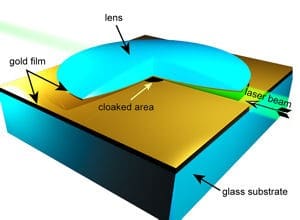Researchers at Purdue University have developed a new type of invisibility cloak that is simpler than previous designs and works for all colors of the visible spectrum. Rather than using expensive “metamaterials” used in other cloak designs, the new design is a far simpler device based on a “tapered optical waveguide”. Waveguides are used in communications technologies including fiber optics.
The research team used their specially tapered waveguide to cloak an area 100 times larger than the wavelengths of light shined by a laser into the device, an unprecedented achievement. Previous experiments with metamaterials have been limited to cloaking regions only a few times larger than the wavelengths of visible light. This research may one day lead to the ability to cloak large objects.
ABSTRACT
Anisotropic Metamaterials Emulated
by Tapered Waveguides:
Application to Optical Cloaking
Igor I. Smolyaninov1, Vera N. Smolyaninova2, Alexander V. Kildishev3, and Vladimir M. Shalaev3
1Advanced Technologies, BAE Systems, Washington, D.C.; 2Dept. of Physics Astronomy and Geosciences, Towson University; 3Birck Nanotechnology Center, School of Electrical and Computer Engineering, Purdue University
We demonstrate that metamaterial devices requiring anisotropic dielectric permittivity and magnetic permeability may be emulated by specially designed tapered waveguides. This approach leads to low-loss, broadband performance. Based on this technique, we demonstrate broadband electromagnetic cloaking in the visible frequency range on a scale ~100 times larger than the wavelength.
For more information visit Purdue’s website.


